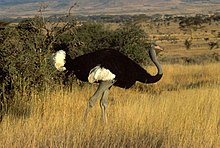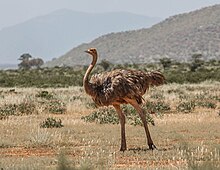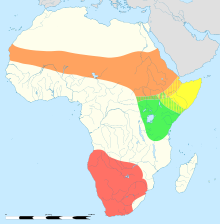Somali ostrich
| Somali ostrich | |
|---|---|

| |
| Male | |

| |
| Female | |
| Scientific classification | |
| Domain: | Eukaryota |
| Kingdom: | Animalia |
| Phylum: | Chordata |
| Class: | Aves |
| Infraclass: | Palaeognathae |
| Order: | Struthioniformes |
| Family: | Struthionidae |
| Genus: | Struthio |
| Species: | S. molybdophanes
|
| Binomial name | |
| Struthio molybdophanes | |

| |
| Yellow area shows range of Struthio molybdophanes | |
| Synonyms[3] | |
| |
The Somali ostrich (Struthio molybdophanes), also known as the blue-necked ostrich, is a large flightless bird native to the Horn of Africa.[4] It is one of two living species of ostriches, the other being the common ostrich. It was also previously considered a subspecies of the common ostrich, but was identified as a distinct species in 2014.[1]
Taxonomy and systematics
Struthio molybdophanes was
Description
Though generally similar to other ostriches, the skin of the neck and thighs of the Somali ostrich is blue (rather than pinkish), becoming bright blue on the male during the mating season. The neck lacks a typical broad white ring, and the tail feathers are white. The males are larger than the females.[9][10] The Somali ostrich is similar in size to other ostriches so far as is known, perhaps averaging marginally smaller in body mass than some subspecies of common ostrich (at least the nominate race, S. c. camelus). Reportedly Somali ostriches in captivity weigh about 105 kg (231 lb) but this may not be an accurate weight for wild birds as captive animals have feeding accesses not available to wild ostriches.[11] It is thus one of the two largest extant bird species.
Distribution and habitat
The Somali ostrich is mostly found in the Horn of Africa, especially in north-eastern Ethiopia, southern Djibouti, most of Kenya, and across most of Somalia.[9]
Behaviour and ecology
The Somali ostrich is differentiated
Status and conservation
A report to the
Notes
- ^ Only populations of Algeria, Burkina Faso, Cameroon, Central African Republic, Chad, Mali, Mauritania, Morocco, Niger, Nigeria, Senegal and Sudan. No other populations are included in the CITES Appendices.
References
- ^ . Retrieved 20 November 2021.
- ^ "Appendices | CITES". cites.org. Retrieved 2022-01-14.
- ^ "Somali Ostrich". Avibase.
- ISBN 978-0-691-17289-7. Retrieved 2018-11-21.
- Sonntags-Beilage zur Norddeutschen allgemeinen Zeitung(in German). No. 37. p. 148 [end of p. 14 in viewer].
- ^ Reichenow, Anton (October 1883). "Immer Neues aus Afrika". Mittheilungen des Ornithologischen Vereines in Wien (in German). 7 (10): 202.
- ^ JSTOR 4088425.
- .
- ^ ISBN 978-92-5-104300-4.
- ISBN 0-313-33545-1.
- ^ Davids, A. H. (2011). Estimation of genetic distances and heterosis in three ostrich (Struthio camelus) breeds for the improvement of productivity (Doctoral dissertation, Stellenbosch: University of Stellenbosch).
- ^ Amir, Osman G. (2006). Wildlife trade in Somalia (PDF). World Conservation Union – Species Survival Commission. p. 12.

